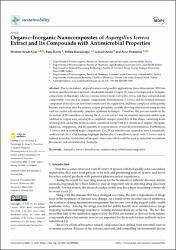Organic-inorganic nanocomposites of aspergillus terreus extract and its compounds with antimicrobial properties
Citation
Uras, I.S., Karslı, B., Konuklugil, B., Öcsoy, İ. & Demirbaş, A. (2023). Organic-Inorganic Nanocomposites of Aspergillus terreus Extract and Its Compounds with Antimicrobial Properties. Sustainability, 15(5), 4638. https://doi.org/10.3390/su15054638Abstract
Due to its distinct, atypical features and possible applications, three-dimensional (3D) hierarchical nanoflowers have sparked considerable interest. Copper (II) ions were employed as inorganic components in this study, whereas various extracts from Aspergillus terreus and their extracted main components were used as organic components. Extracts from A. terreus and its isolated principal component molecules can first form complexes with copper ions, and these complexes subsequently become nucleation sites for primary copper phosphate crystals, showing interactions using an easy and successful self-assembly template synthesis technique. Therefore, the process results in the formation of 3D nanoflowers among the A. terreus extract and its remoted important additives in addition to copper ions, ensuing in a completely unique round flower-like shape containing loads of nanopetals under the most excellent conditions along with pH, attention of organic-inorganic additives, temperature, and the quantity of copper nitrate on nanoflower formation. Furthermore, A. terreus and its isolated major components, Cu-3(PO4)(2) nanoflowers, seemed to have a remarkable antibacterial effect. Our findings highlight the benefits of nanoflowers made with A. terreus and its isolated secondary metabolites of inorganic structures, which could be used in industrial biocatalysts, biosensors, and environmental chemistry.


















